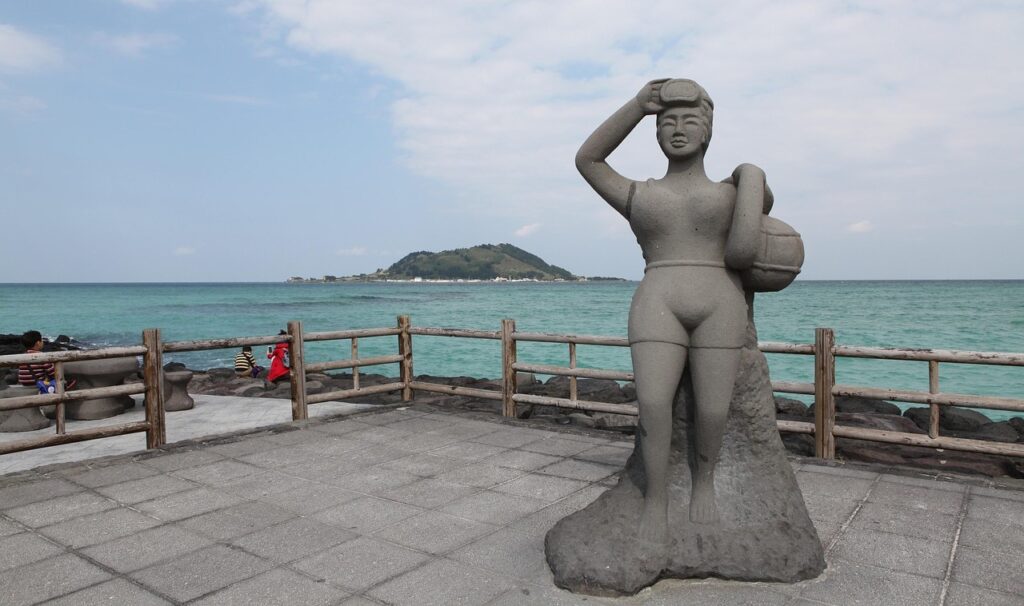Introduction to Haenyeo Culture
Recently, the Netflix drama When Life Gives You Tangerines (폭싹 속았수다) captured the hearts of audiences both in South Korea and internationally. One of the key elements that drew viewers in was the powerful portrayal of Jeju’s Haenyeo — Korea’s traditional women divers. This series showcased the emotional and physical struggles of the Haenyeo of Jeju Island, reflecting a unique and resilient aspect of Korean culture.
In addition, the JTBC and BBC co-produced documentary Deep Dive Korea: Song Ji-hyo’s Haenyeo Adventure brought further global attention to the Haenyeo tradition, emphasizing their strength, spirit, and way of life. Actress Song Ji-hyo’s journey of learning from Haenyeo brought emotional resonance and sparked international interest in this fading tradition.

Who Are the Haenyeo (Women Divers)?
Haenyeo (해녀) literally means “sea women” and refers to female divers in Korea who collect seafood by free-diving without any breathing apparatus. While similar practices exist globally, Korea (particularly Jeju Island) and Japan are the only places where women dive without modern scuba equipment for economic survival.
Known by different names across Korea—such as murekkun in the southern coast and jamnyeo (잠녀) or jamsu (잠수) in Jeju—Haenyeo culture has evolved regionally. Interestingly, the term “Haenyeo” became widely used during the Japanese colonial period but is still rarely used by locals in Jeju, where older terms persist.
A Unique Global Tradition
Though diving for marine products is a universal activity, Haenyeo are globally unique in that they are women who free dive for a living. Jeju Island holds the highest concentration of female divers in the world, making it a cultural and anthropological treasure.
Historically, Jeju Haenyeo didn’t just dive locally—they often traveled to other parts of Korea and even abroad, including Japan, Vladivostok, Qingdao, and more, for seasonal work. These journeys began in earnest after 1850, once the government lifted a long-standing ban (출륙금지령) that had previously prevented Jeju residents from leaving the island.
Tools, Training, and the Haenyeo Lifestyle
Haenyeo collect abalone, sea urchins, octopus, sea cucumbers, conchs, seaweed, and more. Their tools include:
- Te-wak: a buoyant float used for resting and collecting catch
- Mangsi (망시리): a net or bag tied beneath the te-wak
- Bitchang (빗창): a metal tool for scraping shellfish
- Jeongge-homi (정게호미): a sickle for harvesting seaweed
- Galgori (갈고리): an iron hook for gathering shellfish
- Sosal (소살): a harpoon for spearfishing
They wear “mul-ot” (water clothes), now often rubber suits, and “nuns” (goggles), which evolved from small glass lenses to larger masks in the 1950s.
Haenyeo are not born experts; they become skilled through years of training and experience. Young girls in Jeju start learning at the “Aegibadang” (shallow sea) by watching elder divers. Training begins around age 8 and intensifies through their teens. A woman typically becomes a fully active Haenyeo by age 16–18 and can continue diving into her 70s.
They are classified into three groups:
- Sanggung (상군): Highly skilled senior divers
- Junggung (중군): Intermediate divers
- Hagung (하군): Junior or beginner divers
The Cultural Significance of Haenyeo
Haenyeo represent more than just an occupation—they are symbols of Korea’s traditional marine culture and female empowerment. Their practices demonstrate:
- Sustainable fishing techniques
- Community-based knowledge sharing
- Rich folk ecological knowledge
- Rituals and spiritual practices (e.g., Jamsugut for safety and good harvest)
- Oral traditions and songs
Because of these cultural and ecological values, the Jeju Haenyeo culture was designated National Intangible Cultural Heritage No. 132 in Korea in 2017.
In 2016, it was also recognized as a UNESCO Intangible Cultural Heritage of Humanity, under the official name:
“Culture of Jeju Haenyeo (Women Divers)”.
This UNESCO listing highlights elements such as:
- Free-diving harvest techniques without oxygen
- Rituals like “Jamsugut”
- Haenyeo songs sung on boats
- Intergenerational knowledge transmission through mother-daughter relationships

Challenges Facing Haenyeo Today
Despite global recognition, the Haenyeo population is rapidly declining due to:
- Aging divers
- Climate change and ocean warming
- Depleted marine resources
- Difficult working conditions
Many modern efforts are focused on preserving and promoting the Haenyeo heritage. Media projects like Netflix’s When Life Gives You Tangerines and JTBC/BBC’s Deep Dive Korea have played a crucial role in raising awareness and interest globally.
Conclusion
The legacy of Jeju Haenyeo is not only a part of Korean heritage but also a valuable piece of global cultural history. Their story is one of resilience, sustainability, and community, and serves as a powerful symbol of humanity’s relationship with nature.
With increasing attention from international media and institutions, there’s hope that Haenyeo culture will continue to inspire future generations and remain a living heritage of Korea and the world.